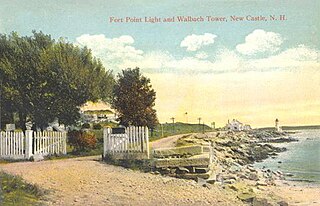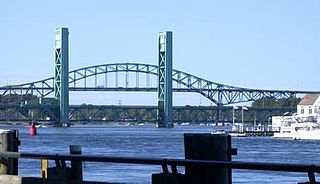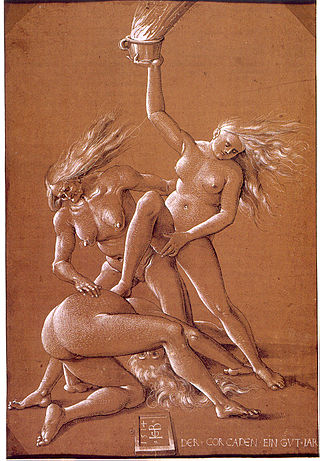Related Research Articles

New Castle is a town in Rockingham County, New Hampshire, United States. The population was 1,000 at the 2020 census. It is the smallest and easternmost town in New Hampshire, and the only one located entirely on islands. It is home to Fort Constitution Historic Site, Fort Stark Historic Site, and the New Castle Common, a 31-acre (13 ha) recreation area on the Atlantic Ocean. New Castle is also home to a United States Coast Guard station, as well as the historic Wentworth by the Sea hotel.

The Salem witch trials were a series of hearings and prosecutions of people accused of witchcraft in colonial Massachusetts between February 1692 and May 1693. More than 200 people were accused. Thirty people were found guilty, nineteen of whom were executed by hanging. One other man, Giles Corey, died under torture after refusing to enter a plea, and at least five people died in jail.
John Proctor was a landowner in the Massachusetts Bay Colony. He and his wife Elizabeth were tried and convicted of witchcraft as part of the Salem Witch Trials, whereupon he was hanged.

The Piscataqua River is a 12-mile-long (19 km) tidal river forming the boundary of the U.S. states of New Hampshire and Maine from its origin at the confluence of the Salmon Falls River and Cochecho River to the Atlantic Ocean. The drainage basin of the river is approximately 1,495 square miles (3,870 km2), including the subwatersheds of the Great Works River and the five rivers flowing into Great Bay: the Bellamy, Oyster, Lamprey, Squamscott, and Winnicut.
Elizabeth Proctor was convicted of witchcraft in the Salem Witch Trials of 1692. She was the wife of John Proctor, who was convicted and executed.

Bridget Bishop was the first person executed for witchcraft during the Salem witch trials in 1692. Nineteen were hanged, and one, Giles Corey, was pressed to death. Altogether, about 200 people were tried.

The Great Works River is a 30.6-mile-long (49.2 km) river in southwestern Maine in the United States. It rises in central York County and flows generally south past North Berwick and joins the tidal part of the Salmon Falls River at South Berwick.

European witchcraft is a multifaceted historical and cultural phenomenon that unfolded over centuries, leaving a mark on the continent's social, religious, and legal landscapes. The roots of European witchcraft trace back to classical antiquity when concepts of magic and religion were closely related, and society closely integrated magic and supernatural beliefs. Ancient Rome, then a pagan society, had laws against harmful magic. In the Middle Ages, accusations of heresy and devil worship grew more prevalent. By the early modern period, major witch hunts began to take place, partly fueled by religious tensions, societal anxieties, and economic upheaval. Witches were often viewed as dangerous sorceresses or sorcerers in a pact with the Devil, capable of causing harm through black magic. A feminist interpretation of the witch trials is that misogynist views of women led to the association of women and malevolent witchcraft.

Mercy Lewis was an accuser during the Salem Witch Trials. She was born in Falmouth, Maine. Mercy Lewis, formally known as Mercy Allen, was the child of Philip Lewis and Mary (Cass) Lewis.

Jonathan Corwin was a New England merchant, politician, and magistrate. He is best known as one of the judges involved in the Salem witch trials of 1692, although his later work also included service as an associate justice of the Massachusetts Superior Court of Judicature, the highest court of the Province of Massachusetts Bay.
In the early modern period, from about 1400 to 1775, about 100,000 people were prosecuted for witchcraft in Europe and British America. Between 40,000 and 60,000 were executed. The witch-hunts were particularly severe in parts of the Holy Roman Empire. Prosecutions for witchcraft reached a high point from 1560 to 1630, during the Counter-Reformation and the European wars of religion. Among the lower classes, accusations of witchcraft were usually made by neighbors, and women made formal accusations as much as men did. Magical healers or 'cunning folk' were sometimes prosecuted for witchcraft, but seem to have made up a minority of the accused. Roughly 80% of those convicted were women, most of them over the age of 40. In some regions, convicted witches were burnt at the stake.

Janet Horne was the last person to be executed legally for witchcraft in the British Isles.

Francis Small was a British-born Colonial American trader and landowner who resided primarily in Kittery, Maine. He made the first recorded land purchase in what is now the state of Maine, then part of Massachusetts, and proceeded to amass so much property that he was called "the great landholder." He owned the most acrerage of anyone who ever lived in Maine.
Margaret Jones was the first person to be executed for witchcraft in Massachusetts Bay Colony, and the second in New England during a witch-hunt that lasted from 1647 to 1693. Hundreds of people throughout New England were accused of practicing witchcraft during that period, including over two hundred in 1692 during the Salem Witch Trials. Prior to the Salem Witch Trials of 1692, over a forty-one year period (1647–1688), nine women, including Margaret Jones, were hanged as witches.
Margaret Bane also called Clerk, was a Scottish midwife and prominent victim of The Great Scottish Witch Hunt of 1597.
Shadrach Walton was a British colonial administrator and soldier in the Province of New Hampshire.

The Bute witches were six Scottish women accused of witchcraft and interrogated in the parish of Rothesay on Bute during the Great Scottish Witch Hunt of 1661–62. The Privy Council granted a Commission of Justiciary for a local trial to be held and four of the women – believed by historians to be Margaret McLevin, Margaret McWilliam, Janet Morrison and Isobell McNicoll – were executed in 1662; a fifth may have died while incarcerated. One woman, Jonet NcNicoll, escaped from prison before she could be executed but when she returned to the island in 1673 the sentence was implemented.
Beatrix Leslie was a Scottish midwife executed for witchcraft. In 1661 she was accused of causing the collapse of a coal pit through witchcraft. Little is known about her life before that, although there are reported disputes with neighbours that allude to a quarrelsome attitude.
The witch trials in Connecticut, also sometimes referred to as the Hartford witch trials, occurred from 1647 to 1663. They were the first large-scale witch trials in the American colonies, predating the Salem Witch Trials by nearly thirty years. John M. Taylor lists a total of 37 cases, 11 of which resulted in executions. The execution of Alse Young of Windsor in the spring of 1647 was the beginning of the witch panic in the area, which would not come to an end until 1670 with the release of Katherine Harrison.

During a 104-year period from 1626 to 1730, there are documented Virginia Witch Trials, hearings and prosecutions of people accused of witchcraft in Colonial Virginia. More than two dozen people are documented having been accused, including two men. Virginia was the first colony to have a formal accusation of witchcraft in 1626, and the first formal witch trial in 1641.
References
- ↑ Benjamin Crocker Clough (1947). The American imagination at work: tall tales and folk tales . A. A. Knopf.
- ↑ Myra Jehlen; Michael Warner (1997). The English Literatures of America, 1500-1800. Routledge. pp. 388–. ISBN 978-0-415-90873-3.
- ↑ The Yale Literary Magazine. Herrick & Noyes. 1887. pp. 95–.
- ↑ Baker, Emerson W. The Devil of Great Island, pp. xiii, Palgrave MacMillan, New York, 2007.
- ↑ Baker, Emerson W. The Devil of Great Island, pp. xiii, 4-5, 7-12, Palgrave MacMillan, New York, 2007.
- ↑ Palmer, Ansell W., ed. Piscataqua Pioneers: Selected Biographies of Early Settlers in Northern New England, pp. 446-7, Piscataqua Pioneers, Portsmouth, NH, 2000. ISBN 0-9676579-0-3.
- ↑ Baker, Emerson W. The Devil of Great Island, pp. 4-5, 7-12, 48-51, 58, 66, Palgrave MacMillan, New York, 2007.
- ↑ Palmer, Ansell W., ed. Piscataqua Pioneers: Selected Biographies of Early Settlers in Northern New England, pp. 446-7, Piscataqua Pioneers, Portsmouth, NH, 2000. ISBN 0-9676579-0-3.
- ↑ Baker, Emerson W. The Devil of Great Island, pp. 177-201, Palgrave MacMillan, New York, 2007.